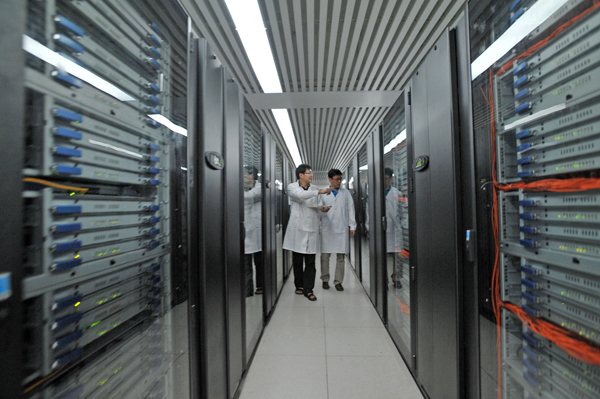Tianhe to run 1 quintillion per second


China's supercomputer can achieve high speed ahead of US, Japan peers
Scientists have set an ambitious target for China's Tianhe-3 supercomputer to meet by 2020, the goal of making a quintillion calculations per second.
The supercomputer is expected to hit the speed-which can also be expressed as a billion billions, or 1 followed by 18 zeros-ahead of the United States and Japan, where their supercomputer scientists are also beefing up efforts to meet the ambitious goal.
"We, however, aren't just working for the great speed but aiming to help quench the country's thirst in more fields in applications with this speed," said Meng Xiangfei, director of the application department at the National Supercomputer Center in Tianjin.
Wider applications have surged including weather forecasting, disaster prevention, energy conservation, and medicines for epidemic outbreaks, to name a few, he said.
Currently 1,600 teams in 20 cities are working with the supercomputer on nearly 10,000 scientific research projects every day.
Tianhe-1 serves more than 1,600 research institutes and companies from more than 20 provinces and regions.
The Tianhe-1 has served 1,200 national-level key innovation projects and generated a combined economic return of up to 3 billion yuan ($459.2 million) for those entities.
Users are taking advantage of the massive computing power to scan the Earth for oil, create artificial nuclear fusion, and build airplanes and maritime equipment.
The supercomputer is now the driving force of the country's innovation in the computer sector and plays an important role in the nation's information security.
The development of the computer has undergone ups and downs.
For example, in 2015, the US banned the export of the chips for Tianhe, but China soon geared up its innovation and enhanced its competitive edge to fulfill the need for top-level chips, central processing units and operating systems.
The ever escalating innovation in big data and artificial intelligence in China will spur the further development of its supercomputer sector.
The supercomputer's growth represents the country's electronic information, integrated circuits, and chip and software sector.
The researcher said now the center is revving up the efforts to conduct research on the 2020 goal, tackling with the challenges of the supportive integrated circuits, chips and software and overall design.
Echoing Meng, Ding Nan, a scientist working for China's fastest supercomputer, Sunway TaihuLight at the Nation-al Super Computing Center in Wuxi, East China's Jiangsu province, said Sunway TaihuLight is coping with the challenges of ever rising demand and the critical need is the software.
"If the memory scales up, the software in memory, applications and security face strong challenges," Ding said.
Ding said that Sunway TaihuLight has the capacity to overcome the barriers, as its technologies and software are entirely independently developed.
Pan Jingshan, deputy head of the National Supercomputer Center in Jinan, capital of East China's Shandong province, said the next generation of Sunway TaihuLight, the prototype of the Sunway Exascale Supercomputer will debut this year and is expected to see its speed hit 4-5 petaflops-4-5 thousand trillions-per second.
China has taken the lead in the hardware of supercomputer and the software has also making headway. The country's supercomputer now is confronted with two major obstacles, energy conservation and wider market applications, Pan said.
In the future the exascale supercomputer with a speed of 1 quintillion calculations per second will consume 30-40 megawatts of energy per hour. The energy demand is a major obstacle hampering the supercomputer's efficiency.
Pan said: "The major challenge as well as the value of supercomputer in China lie in its application. To design state-of-the-art software to meet the calculating demand is key to success."
"Hefty investment is urged to be poured into the sector in a bid to boost the research to serve cutting edge research and development," Pan said.
Zhang Zhihao contributed to the story.



































